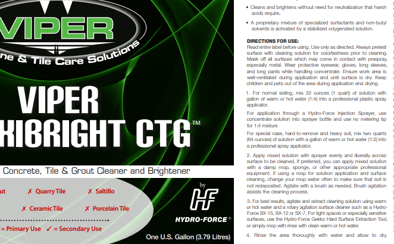Start By Choosing the Appropriate Product
Liquid peroxide formulas clean and brighten grout lines without harsh acids and chlorine bleaches that can damage the grout and surrounding flooring materials. The Liquid peroxide cleans, refreshes, and brightens concrete, tile, and grout without leaving watermarks or residue in contrast to other cleaning chemicals.
Powdered peroxide-based formulas are generally high-performance alkaline, tile and grout cleaners and degreasers that are made for use on heavy-duty concrete. These types of cleaners are a safer alternative to mineral spirits and chlorinated solvent-based heavy-duty concrete degreaser products. These powdered peroxide cleaners penetrate the concrete surface on contact to soften, lift, and remove a wide range of oils, soils, and greases.
A Step-by-Step Application Process
Always read the entire label before using the product, and use it only as directed. Always pre-test the surface with a cleaning solution for colorfastness before cleaning. Wear protective eyewear, gloves, long sleeves, and long pants while handling concentrate. Ensure that the work area is well-ventilated during application. Keep children and pets out of the area during the application of the product and while it is drying.
- Follow label dilution instructions for normal or heavy soiling appropriate for the sprayer that is being used.

- Apply mixed solution with sprayer evenly and liberally across the surface you will clean. You can use a pump-up sprayer or battery-powered sprayer. If preferred, you can apply mixed solution with a damp mop, sponge, or other appropriate professional equipment. If using a mop for solution application and surface cleaning change your mop water often to make sure that soil is not redeposited.
- Allow for 5–10 minutes of dwell-time. For concrete, if stains have been deeply absorbed, allow 15 minutes of dwell-time so the solution has time to reach into the concrete pores and crevices, and so that the oxygen activated effervescent solution can dissolve the soiling and lighten discoloration
- For best results, agitate and extract cleaning solution using warm or hot water and a rotary agitation surface cleaner. For tight spaces or especially sensitive surfaces, use a special hard surface wand, or simply mop, to rinse with clean warm or hot water.

- After the area has been rinsed thoroughly allow the floor to dry. You can accelerate the drying process with an air mover.
- Apply an appropriate concrete sealer or coating. Use a finish mop or rubber squeegee to spread the product evenly across the surface. The sealer can also be sprayed on with a low-pressure pump-up or battery-powered sprayer.
- An optional second coat may be applied to porous concrete after the first coat has dried.

